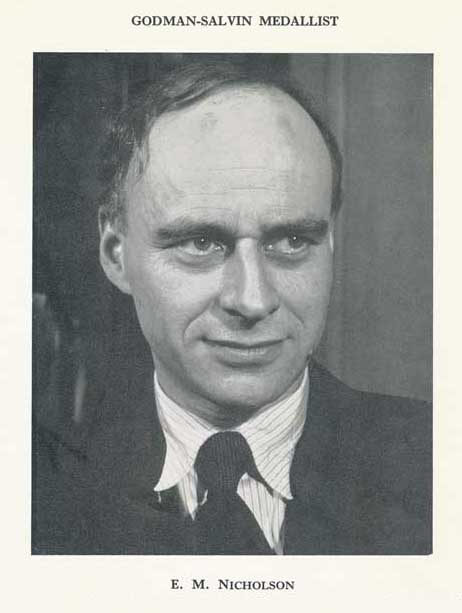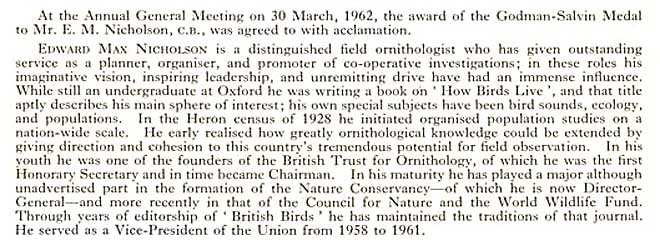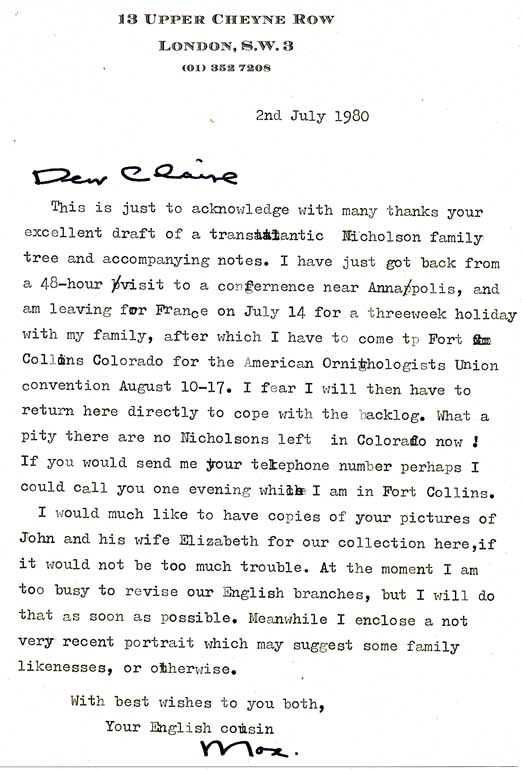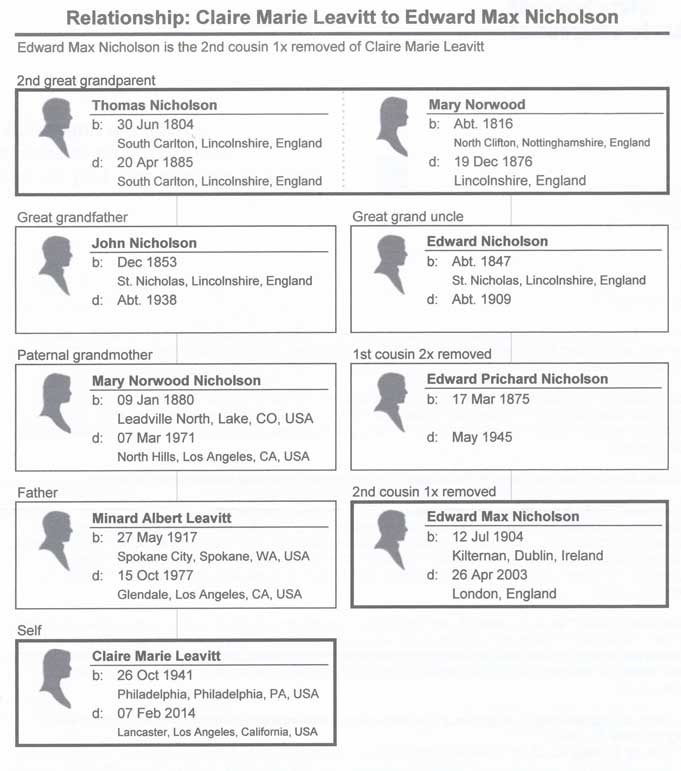|
Edward Max Nicholson and my late ex-wife Claire “Clae” Leavitt Sandin were
second cousins once removed. Our children JR and Stuart are
second cousins twice removed and JR’s children are second cousins thrice
removed. Here is more information about Max’s life.


Edward Max Nicholson 1904-2003
Edward Max Nicholson, ornithologist and environmentalist: born Kilternan, Co
Dublin 12 July 1904; Head of Allocation of Tonnage Division, Ministry of War
Transport 1942-45; Secretary, Office of Lord President of the Council 1945-52;
CB 1948; Director-General, Nature Conservancy 1952-66; chairman, Land Use
Consultants 1966-89; CVO 1971; President, RSPB 1980-85; Chairman, New
Renaissance Group 1996-98, President 1998-2003; married 1932 Mary Crawford (two
sons; marriage dissolved 1964), 1965 Marie Mauerhofer (died 2002; one son); died
London 26 April 2003.
Max Nicholson was a distinguished ornithologist who was
instrumental in the foundation of the World Wildlife Fund (now the Worldwide
Fund for Nature) and the Nature Conservancy (in England, now English Nature), as
first Director-General of which he served from 1952 to 1966. He was also an
environmentalist, with a sweeping vision for the development of London, a
leading figure in the 1951 Festival of Britain, and the founder of the (Silver)
Jubilee Walkway, which now extends over 14 miles through the centre of the
capital.
Sometimes he operated within government organisations, sometimes from outside.
Indeed he saw himself as a scourge of the "Establishment", fervently believing
that Britain could again be a great nation if run by what he called a
"Counter-Establishment". He caused more than a small stir with his 1967 book
The System.
Although he appeared on such radio programmes as Desert Island Discs,
and was active until the end with the New Renaissance Group, Nicholson was never
a household name and, despite the attempts of others to secure honours for him,
most recently in the magazine Country Life in January, he was relatively
un-honoured. He never sought personal glory and tended to be dismissive of those
who had. Instead he sought to get things done, and he was one of those people
that, once you have heard their name, crop up everywhere: he seemed,
mysteriously, to be the mastermind of an enormous number of well-known and
successful enterprises. Having read his unpublished memoirs, I am convinced that
he was an OM manqué.
Edward Max Nicholson came from generations of stolid Lincolnshire farmers. His
father, Edward Prichard Nicholson, was a professional photographer in Dublin,
and his mother, Constance Oldmeadow, was the daughter of the Chief Clerk and
Chief Superintendent of the Cheshire Constabulary. Max was born in 1904 at
Kilternan, south of Dublin, then part of the United Kingdom. The family returned
to England when Max was five, after which his father scraped a living as a
portrait photographer near Staines.
As a young boy, following a visit to the Natural History Museum, and further
inspired by Gilbert White's Natural History of Selborne, he formed a
lifelong interest in bird-watching, and began keeping a list of birds seen,
beginning with the treecreeper, great tit and blackheaded gull in 1913. This
exercise became so extensive that he and Sir Alan Brooke would compare
ornithological notes when attending the Cairo Conference during the Second World
War.
He won an exhibition to Sedbergh (and, when his father failed to complete paying
his school fees, repaid them later himself). After school he spent his time
seeking out and writing about birds – he was proud to claim that by the age of
21 he was one of the few men alive making a living out of birds. He undertook
journalism, produced guidebooks and presently tackled leaders for Geoffrey
Dawson, Editor of The Times. On Dawson's advice, he went up to Hertford
College, Oxford, in 1926, rather later then was usual, with a scholarship to
read History.
At Oxford he founded the Exploration Club, and took part in expeditions to
Greenland in 1928, and to the Amazonian rain forest in British Guiana in 1929.
His interest in birds led him to organise the 1927 Oxford Bird Census and, in
1928, a national census of heronries. In 1932 he was a founder of the British
Trust for Ornithology and its first honorary secretary.
His career as an ornithologist gave him particular pleasure. He found that a
close study of birds gave him rare insight into the ways of men. He relished the
speed with which birds took decisions, and he enjoyed the kind of photographic
memory that enabled him to take a walk in the woods, and then recall the birds
that he had seen with sharp accuracy hours later.
He put his knowledge to good use. There were a variety of books, Birds in
England (1926), How Birds Live (1927), The Study of Birds
(1929), The Art of Bird-watching (1931), and two books of wild-bird songs
in collaboration with Ludwig Koch in the mid-Thirties. Later he produced
Birds and Men (1951), Britain's Nature Reserves (1957) and, as
recently as 1995, Bird-watching in London.
He was Chairman of the British Trust for Ornithology between 1947 and 1949 and
was involved with Peter Scott in founding the Severn Wildfowl Trust. He
initiated and was first chairman and chief editor of the great nine-volume
Oxford series The Birds of the Western Palearctic between 1965 and 1992.
From 1980 to 1985 he was President of the Royal Society for the Protection of
Birds.
In between this overriding interest Nicholson spent many years in public
service. In 1930, he became an assistant editor on the Weekend Review,
drafting in 1931 "A National Plan for Britain", on the basis of which the
socio-economic research organisation Political and Economic Planning (PEP) was
founded; he was its secretary until 1940, and its chairman after the war. He
served on a small team with the Ministry of Information drafting national
messages for the outbreak of war, but resigned in disgust in October 1939.
Meanwhile he also served on an unofficial Post-War Aims Group that advised the
Foreign Secretary, Viscount Halifax, who sent Nicholson and David Astor to Paris
to report on French attitudes in December 1939.
In March 1940 he was head-hunted by Lord Hurcomb and Sir Arthur Salter to the
Ministry of Shipping, serving first as head of their Economic and Inter-Allied
Branch, and then as Head of the Allocation of Tonnage Division (liaising with
Washington) between 1942 and 1945, which involved him in numerous transatlantic
crossings during the Battle of the Atlantic. In his capacity as senior adviser
on the availability of cargo shipping, he attended the conferences at Quebec,
Cairo, Yalta and Potsdam.
Needless to say, he never trusted the Civil Service. He avoided political
parties, despite loving politics, and literary circles, despite being a lifelong
admirer of good English.
Between 1945 and 1952 he was head of the office of the Lord President of the
Council, Herbert Morrison. He accompanied Morrison on critical trips to
Washington, and went to Berlin with him to help boost morale during the historic
airlift of 1949. He took part in Sir Henry Tizard's new advisory council on
Scientific Policy and initiated the Festival of Britain, guiding it through
numerous crises. (Years later Terence Conran told him that as a young man of 20
he had visited the festival, was impressed by the designs, but surprised that no
one was selling them. He decided to have a go.)
In all Nicholson spent six years at the centre of post-war reconstruction, only
returning to the world of birds in 1952, when he became Director-General of the
Nature Conservancy, which he had helped to set up, in his 14 years at the helm
establishing nature reserves and protecting by law Sites of Special Scientific
Interest (SSSIs).
A key achievement was to chair the initial organising committee for the World
Wildlife Fund in 1961. With his friend Aubrey Buxton, he was instrumental in
directing the Duke of Edinburgh towards conservation. The Duke's involvement
with the World Wildlife Fund enabled him to travel the world, virtually as a
head of state, allowing him to make valuable contributions without apparently
straying into the fray of politics, since, as Nicholson enjoyed pointing out,
the politicians of the early 1960s had little conception of environmental
issues.
Other environmental schemes with which he was involved were the International
Institute for Environment and Development (of which he was a founder council
member), the UK Programme Committee for World Conservation Strategy (as Chairman
from 1981 to 1983) and Earthwatch Europe (as first Chairman, 1985-90). Between
1963 and 1972 he was Convenor for the International Council of Scientific Unions
of the conservation section of its International Biological Programme. In more
recent years he founded Land Use Consultants in 1966, serving as chairman. His
last scheme was the New Renaissance Group, which shaped projects for an
over-arching professional College of the Environment, served as an international
training centre for a bio-diversity survey, a Council of Culture and other
bodies with which Nicholson had been closely involved for over 40 years.
More books dealt with these interests, the most notable being The System,
subtitled "The Misgovernment of Modern Britain" and followed by The
Environmental Revolution (1970), The Big Change (1973) and The New
Environmental Age (1987). Sadly no publisher seemed inclined to publish the
autobiography on which he had been working for many years.
With his experience of the Festival of Britain in 1951, and its attendant
problems, Nicholson was not surprised when the Callaghan government showed no
particular interest in celebrating the Queen's first 25 years on the throne in
1977. It took Charles Wintour, then Editor of the London Evening Standard,
and Illtyd Harrington, Deputy Leader of the Greater London Council, to promote
this celebration with a clarion call to the nation on the front page of the
Evening Standard in August 1975.
Far from being in good time for 1977, Nicholson worried that they were too late
to make an impact. However, he saw the Silver Jubilee as an opportunity to lift
the celebrations into "the realm of inspiration and guidance for the future,
which after all was the basis of the Festival of Britain's lasting influence and
prestige".
He developed a document called "The Seven Thrusts" in which he declared he was
not content to leave "a haphazard legacy of scattered unrelated Jubilee halls,
gardens, fountains, seats and suchlike" but intended to initiate an overall plan
for ongoing projects in partnership with local authorities and voluntary bodies.
The first of these was the (Silver) Jubilee Walkway, which aimed to knit London
more closely together, and in particular to lure the walker from Leicester
Square across Lambeth Bridge and on to the South Bank. He wanted the walker to
pass by areas of the city noted for entertainment, assembly, ceremonial,
open-air activities and national history. Nicholson hinted that perhaps this
walker would be subtly changed by what he or she absorbed from "this fertile
heritage". The walkway proved one of the most durable of the environmental
memorials to the Silver Jubilee and has flourished to this day.
His second thrust was to knit north London together by the fuller use of
Regent's Canal and the Grand Union Canal: he was pleased that by opening the
towpath it would be possible to walk 20 miles from the Colne Valley to the Lea
Valley along a car-free route. The other thrusts involved the cleaning up and
development of the Covent Garden area, improvement schemes overseen by the Civic
Trust to develop a London-wide heritage and amenity programme, an extensive
tree-planting programme and the development of "meanwhile" use of derelict land,
which included the creation of an urban farm at Newham. He also masterminded the
Clean Up London Campaign.
I remember sitting with Max Nicholson one afternoon in Hyde Park during one of
the sporting activities of the Silver Jubilee Celebrations. He spelt out his
plans for London and, as with so many men of vision, he made it all sound so
simple. He spoke of how the Thames should again become a working feature of
London life, of his plans for the canals in north London. It was at an unveiling
in connection with the Jubilee Walkway that I met him again some 22 years after
that first conversation. He was as alert as ever in his 97th year.
He told me that he liked to divide his attention into an equal study of the
past, the present and the future. He was against the Establishment, though a
dedicated monarchist, and predicted that the monarchy would survive the 21st
century, since any sensible person would realise that the system was patently
more honourable than a presidency of ambitious and self-serving politicians. He
said that he believed that we had lived through the American century, but that
the two major powers in 50 years' time would be Britain and Russia.
His philosophy as a nonagenarian, he said, was a dialogue between his brain and
his body. He was a believer of mind over matter, but conceded, "I occasionally
give up something as a result of what my body tells me." He drove a car with a
clean licence for over 70 years and, though he had travelled the world from pole
to pole, was contented to spend most of his time in London, in Chelsea, in the
home he had bought some 60 years before.
Nicholson described himself as "impatient, irascible and hyper-critical", often
condemnatory of others, yet he was often seen as a conciliator, a healer of
dissension and a champion of tolerance. When he accepted the Gold Medal for the
World Wildlife Fund from the Duke of Edinburgh in June 1982, he described
himself as a man who had been dreaming for the best part of 78 years.
"Imagination is the stuff that dreams are made of," he said:
"Without it we become prisoners of the built-in stationary bias of our
institutions and our education, with fatal results for society and our own
mental well-being. We miss the essential challenge."
Max Nicholson's voice was one that should have been heard
more widely, but we live in an age when the media are more interested in
scoundrels than men of achievement. He was sanguine about this. "To me the gift
of continuous perception is all the heaven I want," he said.
Hugo Vickers


AFTERWORD
Clae and I met with Max in Santa Monica, California in about 1968 when he
was on a US tour. He and Clae exchanged family information after that
meeting.
As you can see, they were second cousins once removed, making JR and
Stuart second cousins twice removed and JR’s children second cousins thrice
removed. Max was the Ornithologist (Birdman) of the family!
Stuart Sandin and cousin Max Nicholson would have had a lively discussion
about birds. In the mid-90s Stuart worked with endangered birds on the Big
Island, including the ‘akepa, Hawaii creeper, and the 'akiapola'au, banding
birds and catching the birds’ invasive predators.
Then on Maui, Stuart worked with the Maui Critically Endangered Forest
Bird Project through the National Biological Service (now USGS Biological
Resources Division). This project focused on the po'ouli, trying to find
the last remaining individuals (they found three, and now they are all gone).
|
|
|
|
|
|
|